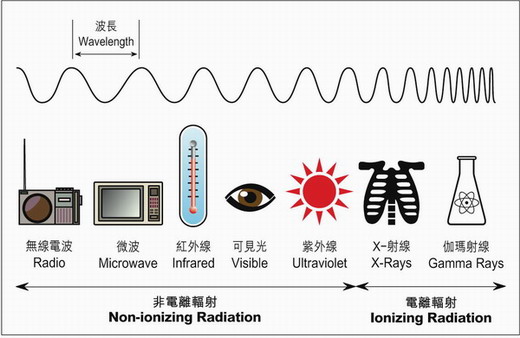
Food Safety Focus (43rd Issue, February 2010) – Food Safety Platform
Microwave Cooking and Food Safety
Reported by Ms. Shuk-man CHOW, Scientific Officer,
Risk Assessment Section, Centre for Food Safety
Besides ionizing radiation introduced in the previous two issues, microwaves are another form of radiation that is commonly used to control foodborne pathogens.
Principles of Microwave Cooking
Microwaves are a form of electromagnetic energy like radio waves and sunlight. They are generated by electricity and capable to pass through glass, paper, plastic, and similar materials. They are used to relay long distance telephone calls, send television communications, and treat muscle soreness. But microwaves are most familiar to us as an energy source for cooking.

Electromagnetic spectrum stretches from radio waves to gamma rays
When food is exposed to microwaves, the energy absorbed causes polar molecules (e.g. water molecules) and ionic compounds (e.g. dissolved salts) to rotate/ vibrate and produce heat to cook the food. Although heat is produced directly in the food, microwaves do not cook, as is commonly believed, from the "inside out". Actually, microwaves penetrate foodstuffs to a depth of about 2.5 to 3.8 centimetres (or 1 to 1.5 inches). In thicker pieces of food, the outer layers are heated and cooked primarily by microwaves while the inside is cooked mainly by the heat conducted from the hot outer layers.
Safety Concerns Associated with Microwave Cooking
Microwave ovens provide a convenient and energy efficient way to thaw, cook and reheat food, and they are commonly used in meal preparation. However, the safety issues on the consumption of microwaved food have attracted public concerns.
Microbiological safety
Nearly all foods are contaminated by microorganisms to certain extent. These microorganisms will be destroyed during microwave cooking just as in other conventional methods, so food can be safely cooked in microwave ovens. However, "cold spot" can occur in microwaved food because of the uneven distribution of electromagnetic field in the oven and the irregular way the microwaves absorbed by the food (e.g. bone can shield the meat around it from thorough cooking). If food does not heat evenly and some parts are left undercooked, bacteria and other pathogens may survive and cause foodborne illness.
To minimise the microbiological risk associated with microwave cooking, a number of national food safety authorities have recommended proper food handling techniques and cooking practices for the use of microwave oven . For example, food for microwave heating should be covered to hold moisture where the steam will help destroy harmful bacteria and ensure safe, even cooking.
Chemical safety
Cooking processes are known to induce the production of potential carcinogens. There have been concerns that microwave cooking may also increase the production of carcinogens or mutagens in food. Currently, there is no tenable evidence that the production of any carcinogenic substances would be increased upon the application of microwave heating.
Nutritional quality
There is concern that microwave cooking will have effects on the nutritional quality of food. In fact, microwave cooking does not reduce the nutritional value of foods any more than other heating methods. Because of the shorter cooking times and less water used, microwave cooking tends to be less harsh on nutrients than conventional cooking methods. According to the U.S. Food and Drug Administration (FDA), foods cooked in a microwave oven may keep more vitamins and minerals.
Radiological safety
Microwaves are nothing related to nuclear energy. They are generated by electricity and use a wavelength similar to television waves, electric shavers and radar. Microwave energy changes to heat as it is absorbed by food, it does not make food "radioactive" or "contaminated".
For more information on the safety of microwaved food and the special cautions to prevent potential burns in heating certain specific food items (e.g. water and egg) with microwave ovens, please refer to our literature review on "Microwave Cooking and Food Safety".


